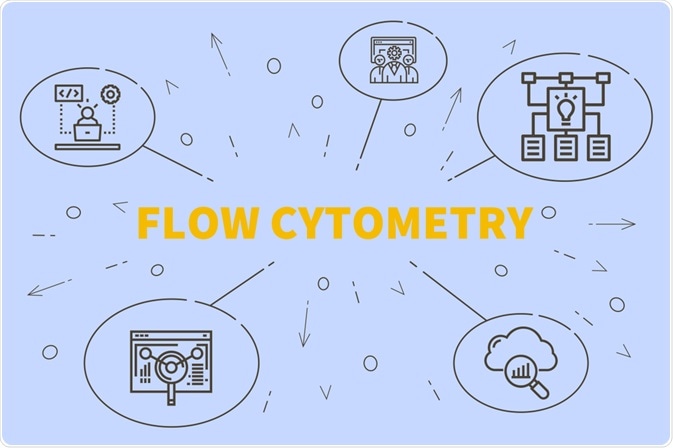Flow cytometry is a high-throughput method of cell analysis wherein live cells are passed in single file by a series of lasers and detectors. The degree of scattering experienced by the laser light can be used to infer a significant degree of information regarding the cell, such as size, density, morphology, and state of apoptosis, and in combination with other techniques such as fluorescent staining cells of interest can be quickly identified and sorted.

Image Credit: OpturaDesign/Shutterstock.com
Fluorophores absorb light of a particular wavelength and subsequently emit at another specific wavelength, and therefore several fluorophores can be utilized simultaneously to highlight multiple cellular structures without interfering with one another. Light of multiple wavelengths may be delivered to passing cells in a parallel or co-linear arrangement, where scattered light is then picked up by multiple detectors, each responsible for a particular range of wavelengths.
Light may be scattered forwards, sideways, or backward by the cell, which are each used to infer different characteristics. For example, as most light passes through the cell and undergoes refraction forward scattered light is used to determine the size of the cell, while side scattered light is proportional to the internal complexity of the cell, with photons being reflected by organelles.
Therefore, all detectors must be aligned to a highly specific angle of incidence, and to ensure that light of the appropriate wavelength reaches the correct detector it must first pass through a series of filters. These filters allow either a continuous range or series of specific wavelengths to pass while reflecting all other light at a 45⁰ angle into an adjacent detector, or mirrors may be utilized earlier to direct the light towards the detector, where filters are placed directly over the aperture.
What are dichroic optical filters?
The filters, mirrors, and detectors utilized in flow cytometry must be carefully selected while considering the fluorophores utilized to achieve optimum signal transmission and detection while reducing background noise. Detectors are based on the conversion of photons to electrons to generate an electrical signal, and the intensity of the electrical signal generated is directly proportional to the number of photons reaching the detector.
However, detectors cannot easily distinguish between light of differing wavelengths, and thus it is essential to narrow the range of light reaching the detector to those associated with the emission wavelengths of the fluorophore in use. This ensures that light emitting from other fluorophores is not mistakenly counted by the detector, and significantly reduces the background noise picked up by the detector.
Combined filters and mirrors that allow certain wavelengths to pass while reflecting others are called dichroic filters or dichroic mirrors. Dichroic filters that allow all light above a specific wavelength to pass are called longpass filters (having a longer wavelength), while those that allow light below a specific wavelength are known as shortpass filters. For example, a 450 nm longpass filter would deflect violet light and allow blue, green, and yellow to pass, while a 450 nm shortpass filter would allow violet light to pass and deflect longer wavelengths.
Bandpass detectors instead allow a range of wavelengths of light to pass through centered at a specific wavelength and exclude extremities, for example, a 520 ±30 nm filter would allow a 60 nm range of wavelengths to pass, centered at 520 nm. Conversely, dichroic mirrors are characterized by the wavelengths of light they reflect, rather than those they allow to pass through, and the mirrored side of the filters utilized in flow cytometry is a further opportunity to refine the wavelengths of light reaching the detector.
Dichroic filters offer several advantages compared to traditional color-based optical filters, not suffering from bleaching following repeated use. Additionally, as non-filtered light is reflected rather than absorbed the filter does not warm during use, allowing more intense light to be used (Dey, 2021).
How do dichroic optical filters work?
Dichroic mirrors or filters are constructed from layers of glass-bound dielectric thin films that refract incident light differentially based on the wavelength of incoming light, in the same way, that glass prisms are able to separate white light. Multiple layers of high and low refractive index layers, which refract more or less strongly, cause incident light to change the speed at each layer boundary.
The thickness and spacing between the layers are engineered to keep light of the desired wavelengths in phase, generating constructive interference, while light not desired to pass through the filter is eliminated by destructive interference.
Dichroic or dielectric mirrors operate identically but in reverse, where the thickness of the low refractive index layer is equal to the wavelength of light wishing to be reflected. As incident light strikes the boundary between each layer a portion will be reflected rather than pass through, and only light of the desired wavelength will undergo constructive interference.
References:
Further Reading
Last Updated: Nov 23, 2021